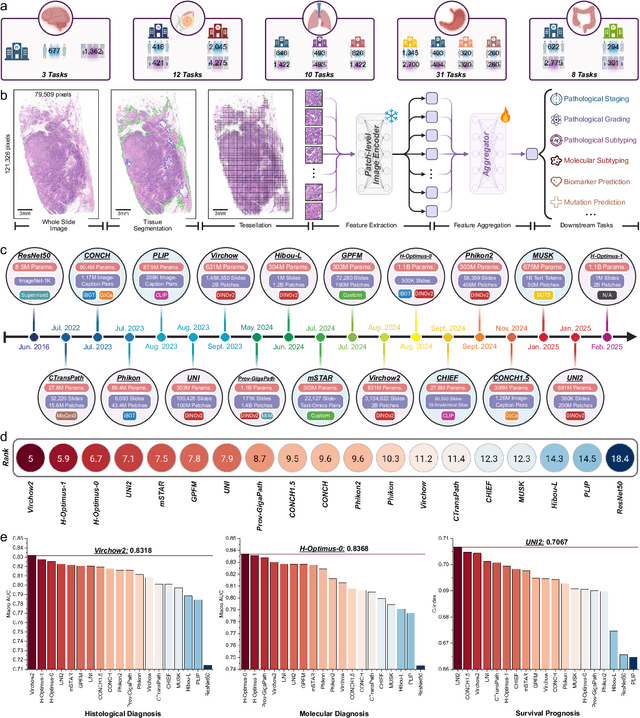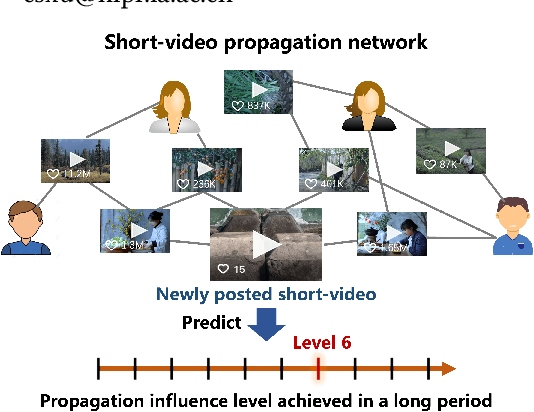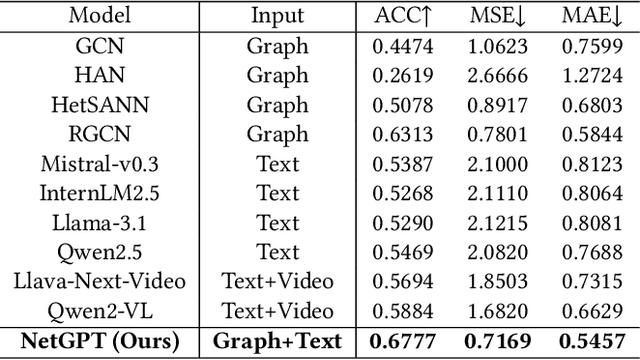Jing Cui
PathBench: A comprehensive comparison benchmark for pathology foundation models towards precision oncology
May 26, 2025



Abstract:The emergence of pathology foundation models has revolutionized computational histopathology, enabling highly accurate, generalized whole-slide image analysis for improved cancer diagnosis, and prognosis assessment. While these models show remarkable potential across cancer diagnostics and prognostics, their clinical translation faces critical challenges including variability in optimal model across cancer types, potential data leakage in evaluation, and lack of standardized benchmarks. Without rigorous, unbiased evaluation, even the most advanced PFMs risk remaining confined to research settings, delaying their life-saving applications. Existing benchmarking efforts remain limited by narrow cancer-type focus, potential pretraining data overlaps, or incomplete task coverage. We present PathBench, the first comprehensive benchmark addressing these gaps through: multi-center in-hourse datasets spanning common cancers with rigorous leakage prevention, evaluation across the full clinical spectrum from diagnosis to prognosis, and an automated leaderboard system for continuous model assessment. Our framework incorporates large-scale data, enabling objective comparison of PFMs while reflecting real-world clinical complexity. All evaluation data comes from private medical providers, with strict exclusion of any pretraining usage to avoid data leakage risks. We have collected 15,888 WSIs from 8,549 patients across 10 hospitals, encompassing over 64 diagnosis and prognosis tasks. Currently, our evaluation of 19 PFMs shows that Virchow2 and H-Optimus-1 are the most effective models overall. This work provides researchers with a robust platform for model development and offers clinicians actionable insights into PFM performance across diverse clinical scenarios, ultimately accelerating the translation of these transformative technologies into routine pathology practice.
Short-video Propagation Influence Rating: A New Real-world Dataset and A New Large Graph Model
Mar 31, 2025



Abstract:Short-video platforms have gained immense popularity, captivating the interest of millions, if not billions, of users globally. Recently, researchers have highlighted the significance of analyzing the propagation of short-videos, which typically involves discovering commercial values, public opinions, user behaviors, etc. This paper proposes a new Short-video Propagation Influence Rating (SPIR) task and aims to promote SPIR from both the dataset and method perspectives. First, we propose a new Cross-platform Short-Video (XS-Video) dataset, which aims to provide a large-scale and real-world short-video propagation network across various platforms to facilitate the research on short-video propagation. Our XS-Video dataset includes 117,720 videos, 381,926 samples, and 535 topics across 5 biggest Chinese platforms, annotated with the propagation influence from level 0 to 9. To the best of our knowledge, this is the first large-scale short-video dataset that contains cross-platform data or provides all of the views, likes, shares, collects, fans, comments, and comment content. Second, we propose a Large Graph Model (LGM) named NetGPT, based on a novel three-stage training mechanism, to bridge heterogeneous graph-structured data with the powerful reasoning ability and knowledge of Large Language Models (LLMs). Our NetGPT can comprehend and analyze the short-video propagation graph, enabling it to predict the long-term propagation influence of short-videos. Comprehensive experimental results evaluated by both classification and regression metrics on our XS-Video dataset indicate the superiority of our method for SPIR.
Recent Advances in Attack and Defense Approaches of Large Language Models
Sep 05, 2024Abstract:Large Language Models (LLMs) have revolutionized artificial intelligence and machine learning through their advanced text processing and generating capabilities. However, their widespread deployment has raised significant safety and reliability concerns. Established vulnerabilities in deep neural networks, coupled with emerging threat models, may compromise security evaluations and create a false sense of security. Given the extensive research in the field of LLM security, we believe that summarizing the current state of affairs will help the research community better understand the present landscape and inform future developments. This paper reviews current research on LLM vulnerabilities and threats, and evaluates the effectiveness of contemporary defense mechanisms. We analyze recent studies on attack vectors and model weaknesses, providing insights into attack mechanisms and the evolving threat landscape. We also examine current defense strategies, highlighting their strengths and limitations. By contrasting advancements in attack and defense methodologies, we identify research gaps and propose future directions to enhance LLM security. Our goal is to advance the understanding of LLM safety challenges and guide the development of more robust security measures.
BadRL: Sparse Targeted Backdoor Attack Against Reinforcement Learning
Dec 19, 2023



Abstract:Backdoor attacks in reinforcement learning (RL) have previously employed intense attack strategies to ensure attack success. However, these methods suffer from high attack costs and increased detectability. In this work, we propose a novel approach, BadRL, which focuses on conducting highly sparse backdoor poisoning efforts during training and testing while maintaining successful attacks. Our algorithm, BadRL, strategically chooses state observations with high attack values to inject triggers during training and testing, thereby reducing the chances of detection. In contrast to the previous methods that utilize sample-agnostic trigger patterns, BadRL dynamically generates distinct trigger patterns based on targeted state observations, thereby enhancing its effectiveness. Theoretical analysis shows that the targeted backdoor attack is always viable and remains stealthy under specific assumptions. Empirical results on various classic RL tasks illustrate that BadRL can substantially degrade the performance of a victim agent with minimal poisoning efforts 0.003% of total training steps) during training and infrequent attacks during testing.
 Add to Chrome
Add to Chrome Add to Firefox
Add to Firefox Add to Edge
Add to Edge